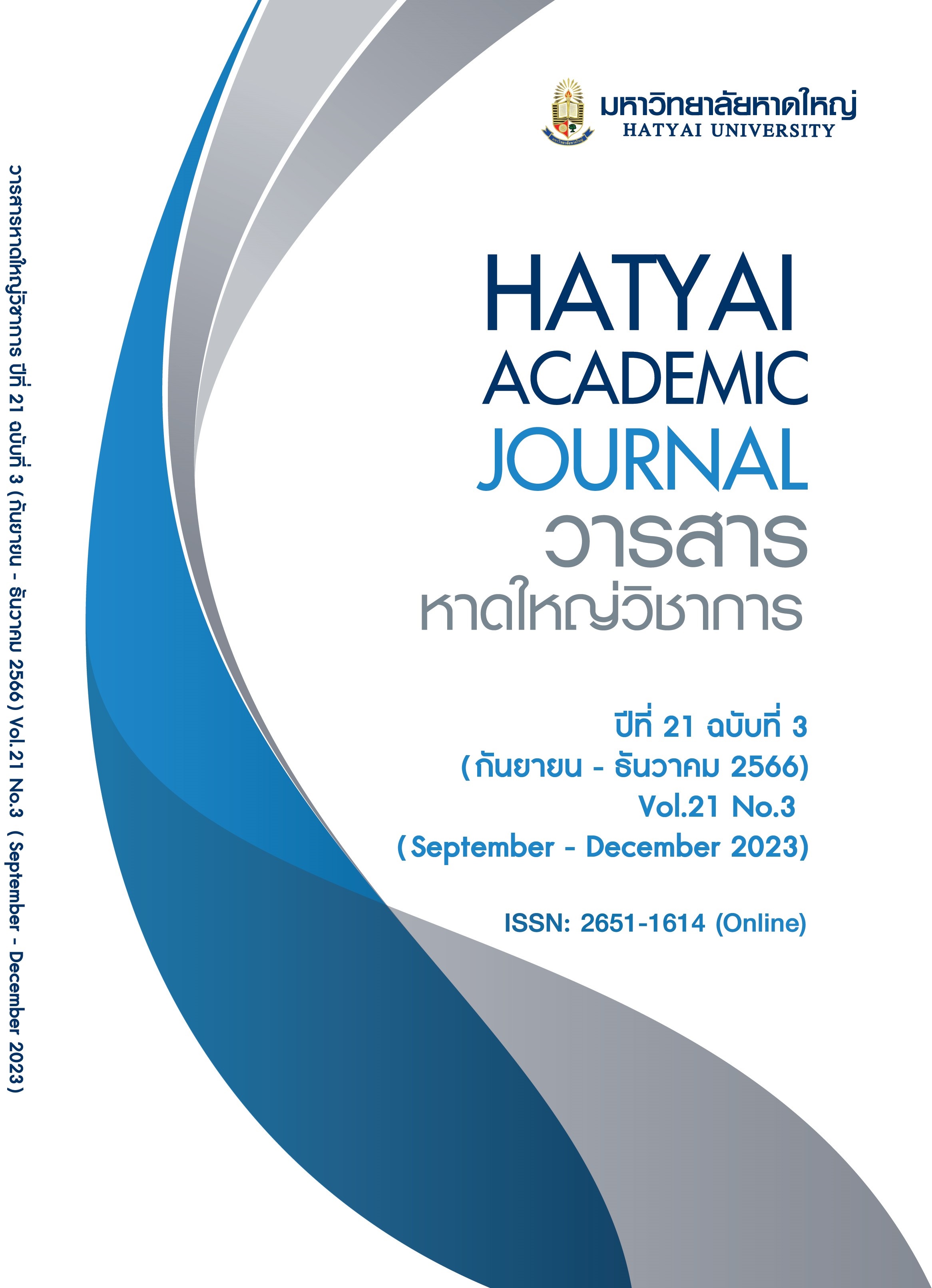ประสิทธิผลการปฏิบัติงานของพนักงานมหาวิทยาลัยสายวิชาการ มหาวิทยาลัยราชภัฏในประเทศไทย
Main Article Content
บทคัดย่อ
การจัดอันดับมหาวิทยาลัยเป็นการวัดคุณภาพของมหาวิทยาลัย โดยการประเมินสมรรถนะหลัก คือ การสอน การวิจัย การบริการวิชาการ และทำนุบำรุงศิลปวัฒนธรรม เพื่อนำผลการประเมินที่ได้ไปรักษามาตรฐานของมหาวิทยาลัย วัตถุประสงค์เพื่อศึกษา 1) ระดับของภาวะผู้นำการเปลี่ยนแปลง บรรยากาศองค์กร ความพึงพอใจในงาน ความผูกพัน และประสิทธิผลการปฏิบัติงาน 2) อิทธิพลของภาวะผู้นำการเปลี่ยนแปลง บรรยากาศองค์กร ความพึงพอใจในงาน และความผูกพัน ต่อประสิทธิผลการปฏิบัติงาน 3) พัฒนารูปแบบจำลองประสิทธิผลการปฏิบัติงาน การวิจัยนี้เป็นการวิจัยแบบผสมผสานเชิงปริมาณและเชิงคุณภาพ กลุ่มตัวอย่าง คือ พนักงานมหาวิทยาลัยสายวิชาการ จำนวน 441 คน ใช้วิธีการสุ่มแบบแบ่งกลุ่ม รวบรวมข้อมูลโดยใช้แบบสอบถาม วิเคราะห์ข้อมูลด้วยสมการโครงสร้าง การวิจัยเชิงคุณภาพใช้วิธีการสนทนากลุ่ม ผลการวิจัยพบว่า 1) ระดับภาวะผู้นำการเปลี่ยนแปลง อยู่ในระดับมากที่สุด บรรยากาศองค์กร ความพึงพอใจในงาน ความผูกพัน และประสิทธิผลการปฏิบัติงาน อยู่ในระดับมาก 2) ภาวะผู้นำการเปลี่ยนแปลง บรรยากาศองค์กร ความพึงพอใจในงาน และความผูกพัน มีอิทธิผลต่อประสิทธิผลการปฏิบัติงานอย่างมีนัยสำคัญทางสถิติที่ระดับ 0.05 และ 3) รูปแบบประสิทธิผลการปฏิบัติงานของพนักงานที่ผู้วิจัยได้พัฒนาขึ้นโดยมีชื่อว่า “T O J E E Model” เป็นรูปแบบในการส่งเสริมสมรรถนะหลักของพนักงานมหาวิทยาลัยสายวิชาการ สร้างความเป็นเลิศของมหาวิทยาลัยราชภัฏที่สอดคล้องกับทิศทางและความต้องการของประเทศ
Article Details

This work is licensed under a Creative Commons Attribution-NonCommercial-NoDerivatives 4.0 International License.
บทความทุกเรื่องจะได้รับการตรวจสอบความถูกต้องทางวิชาการโดยผู้ทรงคุณวุฒิ (peer review) ข้อความและบทความในวารสารหาดใหญ่วิชาการเป็นแนวคิดของผู้เขียน มิใช่ความคิดเห็นของคณะผู้จัดทำ และมิใช่ความรับผิดชอบของมหาวิทยาลัยหาดใหญ่ กองบรรณาธิการวารสารหาดใหญ่วิชาการ ไม่สงวนสิทธิ์การคัดลอกบทความเพื่อใช้ประโยชน์ทางวิชาการ แต่ให้อ้างอิงแสดงที่มาของบทความ
References
Alonderiene, R., & Majauskaite, M. (2016). Leadership style and job satisfaction in higher education institutions. International Journal of Educational Management, 30(1), 140-164.
Bass, B. M., & Bass, R. (2008). The bass handbook of leadership: Theory, research, and managerial application. New York: Free Press.
Bhandarker, A., & Rai, S. (2015). Positive transformational leadership: Case study of an Indian public sector bank. Asia-Pacific Journal of Business Administration, 7(1), 34-55.
Blanz, M. (2017). Employees’ job satisfaction: A test of the job characteristics model among social work practitioners. Journal of Evidence-Informed Social Work, 14(1), 35-50.
Chaudhary, R., Rangnekar, S., & Barua, M. K. (2014). Organizational climate, climate strength and work engagement. Procedia - Social and Behavioral Sciences, 133, 291-303.
Dartey-Baah, K., & Ampofo, E. (2016). “Carrot and stick” leadership style can it predict employees’ job satisfaction in a contemporary business organisation?. African Journal of Economic and Management Studies, 7(3), 328-345.
Fornell, C., & Larcker, D. F. (1981). Evaluating structural equation models with unobservable variables and measurement error. Journal of Marketing Research, 18(1), 39-50. https://doi.org/10.2307/3151312
Frederick, H. (1959). The Motivation to work. New York: John Wiley and Sons.
Hair, J. F., Black, W. C., Babin, B. J., & Anderson, R. E. (2010). Multivariate data analysis (7th ed.). Upper Saddle River: Pearson Education.
Jyoti, J. (2014). Impact of organizational climate on job satisfaction, job commitment and intention to leave: An empirical model. Journal of Business Theory and Practice, 1(1), 157-165.
Kao, R. H. (2016). The relationship between work characteristics and changeoriented organizational citizenship behavior a multi-level study on transformational leadership and organizational climate in immigration workers. Personnel Review, 46(8), 1890-1914.
Kelloway, E. K. (1998). Using LISREL for structural equation modeling: A researcher’s guide. Thousand Oaks, CA: SAGE Publications.
Kim, E. J., & Park, S. (2020). Transformational leadership, knowledge sharing, organizational climate and learning: An empirical study. Leadership & Organization Development Journal, 41(6), 761-775.
Kline, R. B. (2016). Principles and practice of structural equation modeling (4th ed.). New York: The Guilford.
Litwin, G. H., & Stringer, R. A. (1974). Motivation and organizational climate (3rd ed.). Boston: Harvard University Press.
Mansour, J. B., Naji, A., & Leclerc, A. (2017). The relationship between training satisfaction and the readiness to transfer learning: The mediating role of normative commitment. Sustainability, 9(5), 1-14. doi:10.3390/su9050834
Meyer, J. P., & Allen, N. J. (1991). A three-component conceptualization of organizational commitment. Human Resource Management Review, 1(1), 61-89.
Philippaers, K., Cuyper, N. D., & Forrier, A. (2019). Employability and performance: The role of perceived control and affective organizational commitment. Personnel Review, 48(5), 1299-1317.
Ribeiro, N., Yücel, I., & Gomes, D. (2018). How transformational leadership predicts employees’ affective commitment and performance. International Journal of Productivity and Performance Management, 67(9), 1901-1917.
Saleem, M. A., Bhutta, Z. M., Nauman, M., & Zahra, S. (2019). Enhancing performance and commitment through leadership and empowerment: An emerging economy perspective. International Journal of Bank Marketing, 37(1), 303-322.
Soomro, B. A., & Shah, N. (2019). Determining the impact of entrepreneurial orientation and organizational culture on job satisfaction, organizational commitment, and employee’s performance. South Asian Journal of Business Studies, 8(3), 266-282.
Taba, M. I. (2018). Mediating effect of work performance and organizational commitment in the relationship between reward system and employees’ work satisfaction. Journal of Management Development, 37(1), 65-75.
Torlak, N. G., & Kuzey, C. (2019). Leadership, job satisfaction and performance links in private education institutes of Pakistan. International Journal of Productivity and Performance Management, 68(2), 276-295.
Tsai, C. L. (2014). The organizational climate and employees’ job satisfaction in the terminal operation context of kaohsiung port. The Asian Journal of Shipping and Logistics, 30(3), 373-392.
Wang, G. Oh, I. S., Courtright, S. H., & Colbert, A. E. (2011). Transformational leadership and performance across criteria and levels: A meta-analytic review of 25 years of research, Group & Organization Management, 36(2), 223-270.
